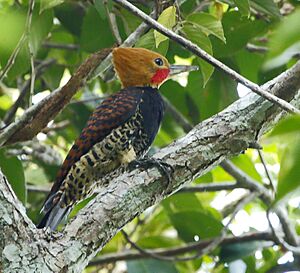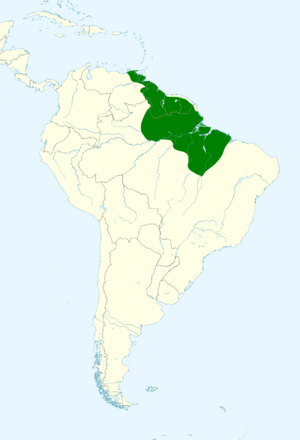Ringed woodpecker facts for kids
Quick facts for kids Ringed woodpecker |
|
|---|---|
 |
|
| A male ringed woodpecker at Vale Natural Reserve, Linhares, Espirito Santo state, Brazil | |
| Conservation status | |
| Scientific classification | |
| Genus: |
Celeus
|
| Species: |
torquatus
|
 |
|
| Range of C. t. torquatus | |
| Synonyms | |
|
|
The ringed woodpecker (Celeus torquatus) is a type of bird that belongs to the woodpecker family. You can find it in many countries in South America. These include Venezuela, Colombia, Ecuador, Peru, Bolivia, Brazil, and the Guianas (French Guiana, Guyana, and Suriname). It is not found in Argentina, Chile, Paraguay, or Uruguay.
Contents
About Its Name
The ringed woodpecker got its first scientific name, Picus torquatus, in 1783. This name was given by a Dutch scientist named Pieter Boddaert. He based it on drawings and descriptions from a French scientist, Georges-Louis Leclerc, Comte de Buffon.
Later, in 1831, a German zoologist named Friedrich Boie placed this bird in a new group, or genus, called Celeus. The name Celeus comes from an old Greek word for a "green woodpecker." The second part of its name, torquatus, is Latin for "collared," which refers to the black band around its neck.
Scientists often group animals into smaller types called subspecies. This article talks about three main subspecies of the ringed woodpecker:
- C. t. torquatus
- C. t. occidentalis
- C. t. tinnunculus
Some scientists think these three subspecies are actually different species. However, this article follows the idea that they are all types of the same ringed woodpecker.
What Does It Look Like?
The ringed woodpecker is about 26 to 29 cm (10 to 11 in) long. That's about the length of a school ruler! Its weight can be between 107 to 135 g (3.8 to 4.8 oz).
All ringed woodpeckers have a light cinnamon-colored head with a reddish tint. They also have a fluffy crest on top of their head. The main difference between males and females is on their face. Males have a red patch on their cheek area, sometimes with other red spots on their head. Females do not have any red on their heads.
The different subspecies have slightly different colors:
- C. t. torquatus (the main type) has a black lower throat, chest, and upper back. Its upper parts are reddish-brown. Its flight feathers (wing feathers) have black and reddish-brown stripes. Its tail is reddish-brown with black stripes and a black tip. Its belly is plain cinnamon-buff.
- C. t. occidentalis has a darker head. Its chest is black, and its back has black stripes. Its belly is more reddish-brown with black stripes.
- C. t. tinnunculus has its whole upper body covered in buffy-reddish brown with black stripes. Its tail feathers are mostly black. Its lower throat and middle chest are black. The rest of its belly is light buffy-white with heavy dark stripes.
All ringed woodpeckers have long beaks. Their eyes are red or reddish-brown, and their legs are gray or dark gray. Young woodpeckers look like adults but have more black on their face and more stripes on their upper body.
Where Does It Live?
The three subspecies of the ringed woodpecker live in different areas:
- C. t. torquatus lives in northeastern Venezuela, the Guianas, and northern parts of the Amazon rainforest in Brazil.
- C. t. occidentalis is found in southeastern Colombia, southern Venezuela, northeastern Ecuador, eastern Peru, northern Bolivia, and western and central Amazonian Brazil.
- C. t. tinnunculus lives only in eastern Brazil, in the states of Bahia and Espírito Santo.
Most ringed woodpeckers prefer to live in tall, humid tropical forests. They can also be found in flooded forests, younger forests that are growing back, and forests along rivers. They live from sea level up to about 950 m (3,120 ft) high in the mountains, depending on the region.
How It Behaves
Movement
The ringed woodpecker stays in the same area all year round. It does not migrate.
Feeding Habits
This woodpecker finds its food in different ways depending on where it lives. Most of the time, it looks for food from the lower parts of the forest up to just below the treetops. In some western areas, it prefers to search higher up in the trees.
It usually forages alone or in pairs. Sometimes, you might see them in small groups. They eat ants, seeds, and fruit. They find food by picking it off surfaces, chiseling small holes into wood, and hammering into termite nests to open them up.
Reproduction
Scientists do not know much about how ringed woodpeckers raise their young.
Sounds and Calls
The sounds made by the different subspecies of ringed woodpeckers are quite similar. They have a "primary call" which is like a song. It's a series of 2 to 7 loud, clear whistles that sound like "klee-klee-klee-klee."
They also have a "rising call," which is 4 to 9 loud, sharp whistles that get higher in pitch. Another sound is a "whinny," a short and fast series of 4 to 6 shrill notes, with the last note being lower.
Most of their calling happens at dawn (sunrise). They are very quiet during the rest of the day. Both male and female woodpeckers also drum on trees, but not very often. Their drumming lasts about 1 to 2 seconds.
What About Its Future?
Scientists keep track of how many ringed woodpeckers there are to make sure they are safe. Because some scientists think the three subspecies are separate species, they are each checked on their own.
- The ringed woodpecker (C. t. torquatus) is listed as Near Threatened. This means it could become endangered in the future. Even though it lives in a large area, its population size is unknown and is thought to be shrinking. The biggest danger to this bird is the cutting down of forests in the Amazon. Forests are cleared for cattle farms and growing crops like soy.
- The "Amazonian black-breasted woodpecker" (C. t. occidentalis) is listed as Least Concern. This means it is not currently at risk. It also lives in a large area, and its population is unknown but thought to be decreasing. However, no immediate threats have been found for this subspecies.
- The "Atlantic black-breasted woodpecker" (C. t. tinnunculus) is listed as Vulnerable. This means it is at high risk of becoming endangered. It lives in a smaller area, and its population is also unknown and believed to be shrinking. Less than 20% of its original forest home, the Atlantic Forest, is left. Much of what remains is broken up into small pieces. This habitat is being lost to farming, ranching, and tree plantations.


